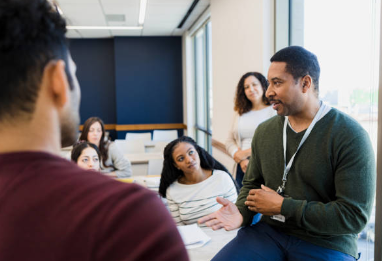Shifting the Focus for Professional Development in Health and Physical Education

Previously published in Volume 85, Issue 1
Abstract
Educational research suggests factors such as excessive teacher workloads, poor management, a lack of autonomy, and fewer opportunities for creativity are causing teaching to become an unsustainable profession (Braga, Jones, Bulger, & Elliott, 2017, Patton & Parker, 2014). Instead of a radical rethink of the profession, many “piecemeal” solutions have been offered to help solve deeply rooted problems in education, including professional development (Armour & Yelling, 2004).
Professional development (PD) is a means to maintain high quality practice and is widely identified as an implicit responsibility of professionals (Webster-Wright, 2009). There are two major dilemmas facing PD in the field of health and physical education (HPE): ineffective utilization of PD, and marginalization of the field of HPE. First, despite recognition of its importance to the professional growth of teachers, PD remains woefully inadequate, as PD opportunities are often fragmented, intellectually superficial, and disregards what is known about how teachers learn (Patton & Parker, 2014). Many traditional models of PD tend to focus only on the acquisition of knowledge and teaching skills (Armour & Yelling, 2004) in an often disjointed, form of delivery. As a result, traditional PD in physical education (PE) has shown minimal effects on the quality of teaching and student learning (Braga, Jones, Bulger, & Elliott, 2017). Secondly, physical education as a curricular subject is facing a comprehensive threat towards its existence (DeCorby, Halas, Dixon, Wintrup, & Janzen, 2005) as political attention in education is being directed towards academic standards such as literacy and numeracy (Penney, 2008).
Schwager (2014) explained the difficulties faced while trying to build and maintain effective physical education programs. Barriers that PE programs may face include a lack of interest from students and parents, the devaluation of PE subject matter, and a lack of administrative support. It is understood that the future of physical education and educational reform ultimately relies on the continuous growth and development of teachers (Patton, Parker, & Pratt, 2013).
Therefore, one would believe a shift in the use and type of PD in HPE is necessary in order for HPE to be legitimized and seen as a priority subject in public education. Effective utilization of HPE PD is possible through the use of continuous learning models of professional development, collaboration of teachers, and effective facilitation of teacher learning. While simplistic in nature, PD that favors continuous learning of teachers collaborating with one another through effective facilitation has the influence of dramatically improving current approaches to professional development in the field of HPE. Throughout this article, an in-depth analysis will be examined towards a need for change in the orientation of HPE professional development, and key elements to potentially improve the use of HPE professional development.
The need for change in the orientation of HPE professional development
A shift in the orientation and delivery of professional development for HPE teachers is necessary for a variety of reasons. Physical education curriculum has experienced a process of conceptualization since the mid 20th century (Ennis, 2006). Curriculum is known as education’s plan for facilitating learning (Jewett, 1980), therefore, if curriculum is changing and evolving, teachers must inevitably change and evolve as well. Armour & Yelling (2007) explained that the professional community of teachers is an important contributor towards instructional improvement and school reform. However, while physical education is considered as a less valuable subject than other content areas, many physical educators feel isolated and limited in resources (Sears, Edgington, & Hynes, 2014). Such perceptions can lead to teacher washout. Washout is referred as the “erosion of pedagogical skills learned during preservice teacher education including planning, implementation of new curricular ideas, and assessment of students learning” (Henninger & Carlson, 2011, p. 17). Washout can negatively affect teachers’ ability to provide quality physical education for students, contributing to the devaluation of learning content (Henninger & Carlson, 2011). Subsequently, meaningful professional development of health and physical education teachers is necessary in order to avoid teacher washout.
Another need for change in the orientation of HPE PD is that teacher education must be understood as a career-long process. Teachers as lifelong learners seek to build their teaching capacities in order to better understand their roles as teachers (O’Sullivan, 2007). Teacher education programs cannot guarantee that teachers have learned everything they need in order to become proficient teachers but try to provide a comprehensive program that attends to all of the possible requirements. Teacher preparation programs often assume that teachers should be fully equipped with the technical skills needed to be a successful teacher. In reality, teachers must continue to develop as they progress through their teaching careers (Stremmel, 2015).
Stremmel (2015) explained that teachers typically experience at least three different distinct stages throughout their teaching career. The first stage is focused on survival, as teachers are initially concerned with becoming comfortable being in front of children, having a sense of control in the classroom, and trying to get children to respect and like them. During the second stage, teachers become more focused on mastering curriculum, developing competencies, and learning procedures and strategies in order to become effective teachers. It is believed that some teachers will stay stuck in the second stage throughout the entirety of their teaching careers. During the third stage, teachers are no longer just teaching a set of curriculum, they now feel more creative and innovative, as they have developed a unique self and pedagogical orientation with their students. This empowers them to learn as teaching becomes an extension of one’s own being (Stremmel, 2015).
One may question; how do teachers reach the third stage of teaching? Stremmel (2015) suggested that teacher preparation should be reframed as teacher development, as the goal of teacher education should not simply be to develop teaching expertise, but instead to foster genuine and ongoing professional learning throughout one’s career. A starting point for effective professional development is to help teachers rid prior judgments of what classrooms and pupils should look like, and instead, focus on what is actually happening in their classrooms (Armour & Yelling, 2004). This may allow teachers to shift their mindset towards the belief that teacher education is a lifelong process and professional learning must continue throughout their careers.

Continuous professional development
The problem with many traditional PD models in the field of education is they do not meet the needs of experienced teachers, as traditional models tend to focus mostly on the acquisition of subject knowledge and teaching skills (Armour & Yelling, 2007). Training becomes irrelevant and little connection to previous learning is attained. Teaching cannot be seen as simply a cognitive process, it also requires a certain degree of emotional commitment. PD must consider the personal, moral, and political dimensions related to teaching (Armour & Yelling, 2004).
Ongoing training of teachers is necessary for HPE as the quality of students’ learning in physical education is largely dependent on the quality of teaching (Elliot & Campbell, 2015). A potential solution to problems related to traditional models of PD may be continuous professional development (Armour & Yelling, 2004). Continuous professional development (CPD) is defined as “all types of professional learning undertaken by teachers beyond the initial point of training” (Armour & Yelling, 2004, p. 96). CPD programs are designed to deepen teacher content knowledge, refine instructional strategies while fostering reflective and collaborative practices in order to enhance the quality of physical education and the learning of students (Braga et al., 2017).
Four key features consistently appear in relation to effective and meaningful CPD (Braga et al., 2017). First, CPD should focus on student learning. CPD content centers on what students are to learn and how teachers will teach it. Second, emphasis is given towards content development with the aim to improve teachers’ content knowledge and pedagogical skills. Third, it is suggested that effective CPD involves the learning of teachers within a network of professionals, which involves a range of stakeholders (Braga et al., 2017). CPD must include learning opportunities where teachers are motivated to learn through practice and draw from outward expertise while interacting with colleagues. A critical element towards the development of effective CPD is to establish a supportive structure that values the professional development of teachers while providing the necessary resources in order to transfer information into their classrooms (Braga et al., 2017).
CPD in physical education has had practical and positive impacts within educational settings. A study was conducted in American middle schools involving physical education teachers engaged in a CPD initiative related to planning and implementing a specific PE unit (Braga et al., 2017). The purpose of the study was to examine perceptions of teachers regarding their experiences in a one-year research-informed CPD initiative that was conceptualized around the four key features of CPD (student learning, content development, collaboration, school support). The findings of the study produced four dominant themes. First, participants valued the experience of the CPD initiative and developed positive dispositions towards the planning and delivery of the unit. Second, as teachers began to implement the unit, they reported changes to their approach to certain functions of teaching including management of students and equipment, and instructional style. Teachers also noticed a difference in the way they interacted with their peers as they began interacting more frequently with co-workers and more often asked co-workers for suggestions and input towards issues related to management, safety, and student abilities. Third, teachers noticed a difference in student response. Teachers adapted, modified and extended their instruction to accommodate the needs of all learners with diverse abilities. Despite instructional challenges, teachers were confident that students had acquired new skills and progressed proficiently through the unit. Consequently, there was an increased level of student motivation and engagement throughout the unit. Finally, perhaps the most significant theme that emerged was teachers found that being involved in the CPD workshop became more than just an educational exercise. Data suggested teachers were examining and seeking strategies to strengthen the specific unit and increase the likelihood that the unit would be delivered during future semesters. Participants described elements such as organizational support and instructional resources were imperative in order to sustain the unit for the future (Braga et al., 2017). Teachers displayed various ideas and tenants of empowerment. Empowerment is described as a “social process that enables individuals to gain ownership over their actions and develop the necessary self-confidence to overcome challenges and accomplish tasks” (Braga et al., 2017, p. 301). The positive effects of CPD use in HPE are evident. A lifelong learning model such as CPD implies much more attention be fixated on supporting teachers and providing incentives and resources towards ongoing PD (Armour &Yelling, 2004; O’Sullivan, 2007).
The effect of quality CPD should not be underestimated as access to quality professional development has been identified as a key element to raising educational standards and may act as a decisive factor for the retention of teachers (Armour & Yelling, 2004). PD should empower teachers to undertake increased responsibility towards making improvements that positively affect students’ learning (Braga et al., 2017). It can be argued that fundamental questions about physical education teacher development, its impact on pupil learning, and the nature of effective continuous professional development for health and physical education are overdue.

Collaborative professional development
PD programming has been viewed with cynicism as something done to teachers instead of with teachers (O’Sullivan, 2007). Often teachers are on the receiving end of educational directives rather than being seen as the key stakeholders with a central understanding of what needs to be improved in the teaching and learning environments in which they work (Armour & Yelling, 2007). As educational reform efforts have called for change in the ways teachers exchange information and interact with one another, efforts have focused on creating a collaborative culture by increasing teacher interaction in formal and informal settings (Carpenter, 2018; O’Sullivan, 2007). Collaboration is understood as the intellectual social norming of communicating and working with others while working towards a common purpose and goal (Carpenter, 2018). As O’Sullivan (2007) explained, teachers must be provided with opportunities to engage in dialogue and action with one another in order to address problems of practice and policy while building their professional capacities. In doing so, teachers are able to develop stronger identities as teaching professionals.
Professional learning communities and communities of practice
The collaborative culture of teaching can be strengthened through the use of Professional Learning Communities (PLC) and Communities of Practice (CoP). A PLC is organized to create opportunities for teachers and administrators to share a common workspace as well as a commonality in a collaborative setting (Carpenter, 2018). Using a PLC model of PD provides many benefits towards teacher learning and development. Teaching in a PLC driven environment enables a departure from teachers having to work in isolation, allowing HPE teachers to create quality programs together (Beddoes, Prusak, & Hall, 2014). PLCs allow HPE teachers to collaborate in the creation of common assessments and provide ongoing in-service PD specific to the unique nature of health and physical education. A PLC also provides HPE teachers opportunities to create a “critical mass” with a common voice in order to advocate for the value and uniqueness that PE can make towards educating the whole child (Beddoes et al., 2014). The benefits of a PLC extend beyond the grasp of experienced teachers. As the beginning years of teaching are critical towards the development of a teacher, novice teachers may benefit from the experience of veteran teachers. A nurturing PLC environment will enable novice teachers to contribute to dialogue by sharing new ideas and current research they may bring from teacher preparation programs (Beddoes et al., 2014). Another benefit of establishing a PLC group is the opportunity to collaborate with teacher preparation programs. Prusak, Pennington, Graser, Beighle, and Morgan (2010) explained that the relationship between an HPE PLC group and physical education teacher education (PETE) programs could be of great value towards educating PLC groups. By collaborating, teachers are prepared with the latest information about the field of HPE as well as being a crucial resource towards ongoing professional development of in-service teachers. Building this type of relationship could attend to enlighten teacher preparation programs of emerging needs within current school settings. Additionally, by creating PLC-PETE partnerships, pre-service teachers may have a chance of completing their student teaching within the school division of the given PLC group. This enables the opportunity for more seamless transition of teachers from undergraduate coursework through pre-service teaching into the early months and years of professional teaching, as the same curriculum, management, and instructional methods could be used at all stages of teacher development (Prusack et al., 2010).
A CoP is a group that develops relationships, works on meaningful topics and “develop among themselves their own understandings of what their practices and profession are about” (O’Sullivan, 2007, p. 11). The key premise underpinning a CoP is learning is interpreted a social process and comes from one’s daily experiences. Conditions for improving both teaching and learning are strengthened when its members can collectively question ineffective teaching routines, explore new conceptions of teaching and learning while actively engaging in professional growth. CoPs provide a space and place for PE teachers to have the opportunity to participate in conversation and action about the direction and nature of their work with children. A CoP should include interactions where participants evaluate the perspectives of others, teach participants to understand historical locatedness of their practices, build practical theories of teaching and learning, and enable participants to improve anticipation of future possibilities for their subject area and profession (O’Sullivan, 2007). PLCs and CoPs differ in their fundamental ways. A CoP focuses on the needs and interests of the teachers and often favors process over product. Participants also have the ability to decide what information and topics to discuss without specific prompts from administrators or school districts, allowing topics for discussion to arise in a more organic nature (Johnson, T. G., Moorcroft, S. J., Tucker, K. M. B., Calvert, H., & Turner, L. 2017). Because a CoP habitually favors process over product, it dismisses the idea for quick solutions and results that often desired in teaching and permits for a greater opportunity for HPE teachers to have worthwhile conversations with other professionals about teaching. This may allow teachers to be more reflective of their teaching as they are not solely focused on the learning of students and the production of student learning results. A CoP does not necessarily involve all members of an organization, but instead focuses on regular and informal interactions that may arise among a group involved within an organization (Johnson et al., 2017). This can be beneficial to teachers working in isolation as they then have the ability to meet with HPE teachers outside of their school as part of a CoP and collaborate in a professional manner. For example, a CoP may include a small group of members within a school district that regularly and informally meet and collaborate to share experiences, successes, and challenges towards teaching HPE (Johnson et al., 2017). As CoPs do not necessarily include all members of a specific school or school division, it supports the opportunity for HPE teachers to work and collaborate with other HPE professionals in settings alternative to a PLC. The potential of collaborating with HPE teachers outside of one’s own school may strengthen the limitation of always collaborating with the same teachers as found in a PLC.

Facilitation of teacher learning in professional development
While continuous and collaborative growth and development of teachers is necessary towards HPE and educational reform, the responsibility cannot solely be that of teachers themselves. The collectives of teachers, administrators, and other key stakeholders must work together to move forward not only to gain knowledge but also to develop professional capital (Patton et al., 2013). A combination of human, social, decisional capital, and professional capital is known as “the asset of teachers making decisions in complex situations with collective responsibility” (Patton et al., 2013, p.441).
Continuous professional development and a set of coherent actions to help teachers learn must be at the forefront in order to develop professional capital. Effective PD must be facilitated with care. It requires both firmness and persistence to challenge learners. Teachers as learners need to be able to discover and make meaning of themselves (Patton et al., 2013). The use of facilitation as a guiding tool while concerning teacher learning has proven to be imperative towards continuous and collaborative professional development of HPE teachers. Johnson et al. (2017) reported that effective facilitation of collaborative learning environments for teachers is a primary element towards collaborative effectiveness.
Adhering to a constructivist approach to learning, facilitation must underscore the role of prior knowledge and the social nature of learning while emphasizing various aspects of capacity building in teachers (Patton & Parker, 2014). Patton et al. (2013) explained that constructivist views to learning have been broadly accepted by educators, which may include coaching, mentoring, participating in PLCs or CoPs, and engaging in self-directed learning to understand new teaching strategies and concepts. Taking on a constructivist learning theory for professional development emphasizes the importance of “teachers actively constructing knowledge and highlights the significant role of facilitators in that task” (Patton et al., 2013, p. 443). Successful PD facilitation requires individuals working with a core group of teachers to explore the complexities associated to creating PD that is both meaningful and supported by theories of teacher learning (Patton & Parker, 2014).
Facilitation of HPE professional learning has many benefits when properly utilized. A study by Patton et al. (2013) found many PD strategies were effectively utilized by means of facilitation to increase teacher development. Facilitators used social and active learning opportunities, which allowed learning to occur because of interactions with others within informal settings. During these sessions, teachers were able to share and consult with one another to reflect upon practices, increase knowledge, and find solutions to difficult problems. The role of the facilitator was to help plan gatherings, often in non-work related venues. Facilitators also implemented the strategy of monitoring teacher discussions and interjecting at opportune times. Facilitators provided support to teachers by supplying information selectively, which allowed teachers to refine their teaching and lead them to plausible solutions while encouraging teachers to take control of the PD process. Strategies were also implemented to reinforce continual learning between meetings. The strategies were designed to extend teachers’ engagement and professional learning by being able to try out new ideas and follow up with other teachers by critically discussing outcomes. Teachers were then encouraged to share their learning as public presentations of work (Patton et al., 2013). The use of facilitation plays a vital role in helping teachers make changes towards deeply held beliefs, habits of practice, and knowledge (Patton & Parker, 2014).

Conclusion
Teachers are seen as important contributors towards the improvement of student learning and educational reform (Armour & Yelling, 2007). The growth of teachers’ professional development is imperative if one wishes to see improvements towards the progression of educational transformation (Armour & Yelling, 2004). The matter at stake is not why HPE teachers need opportunities for professional development, but instead, how can HPE teachers effectively utilize the means of professional development in the field of HPE. Barriers such as a lack of interest and increased resistance towards PE, devaluation of PE subject matter, minimal administrative support (Schwager, 2014), and increased political attention towards academic standards such as literacy and numeracy (Penney, 2008) have created a sense of marginalization towards the field of HPE. One would argue that the need for effective professional development of HPE teachers would prove to be an important factor towards the continued existence of the field of HPE. Traditional models of PD in HPE are often viewed as inadequate, fragmented, and superficial (Patton & Parker, 2014). Therefore, modifications towards the delivery and utilization of professional development for health and physical educators are necessary. If it is a teacher’s desire that their students continuously mature and develop as learners throughout their lives, then all teachers must follow the same model of continuous growth and development as professional learners throughout their careers. Professional development that favors continuous learning by teachers who collaborate with one another, with the use of facilitation, has the effect of dramatically improving current approaches to professional development in the field of health and physical education.
References
Armour, K., & Yelling, M. (2004). Continuing professional development for experience physical education teachers: Towards effective provision. Sport, Education and Society, 9(1), 95 114.
Armour, K., Yelling, M. (2007). Effective professional development for physical education teachers: The role of informal, collaborative learning. Journal of Teaching in Physical Education, 26(2), 177-200.
Beddoes, Z., Prusak, K. A., & Hall, A. (2014). Overcoming marginalization of physical education in america's schools with professional learning communities. Journal of Physical Education, Recreation & Dance, 85(4), 21-27.
Braga, L., Jones, E., Bulger, S., & Elliott, E. (2017). Empowering teachers to implement innovative content in physical education through continuous professional development. Teacher Development, 21(2), 288-306.
Carpenter, D. (2018). Intellectual and physical shared workspace. The International Journal of Educational Management, 32(1), 121-140.
DeCorby, K., Halas, J., Dixon, S., Wintrup, L., & Janzen, H. (2005). Classroom teachers and the challenges of delivering quality physical education. The Journal of Educational Research, 98(4), 208-220.
Elliot, D. L., & Campbell, T. (2015). ‘Really on the ball’: Exploring the implications of teachers' PE-CPD experience. Sport, Education and Society, 20(3), 381-397.
Ennis, C. (2006). Curriculum: Forming and reshaping the vision of physical education in a high need, low demand world of schools, Quest,58:1, 41-59.
Henninger, M. L., & Carlson, K. B. (2011). Strategies to increase the value of physical educators in K-12 schools. Journal of Physical Education, Recreation & Dance, 82(6), 17-20.
Jewett, A. (1980). The Status of Physical Education Curriculum Theory, Quest, 32:2, 163-173.
Johnson, T. G., Moorcroft, S. J., Tucker, K. M. B., Calvert, H., & Turner, L. (2017). Communities of practice: A possible professional-development model for physical activity leadership. Journal of Physical Education, Recreation & Dance, 88(9), 3-5.
O'Sullivan, M. (2007). Creating and sustaining communities of practice among physical education professionals. New Zealand Physical Educator, 40(1), 10-13.
Patton, K., & Parker, M. (2014). Moving from ‘things to do on monday’ to student learning: Physical education professional development facilitators' views of success. Physical Education and Sport Pedagogy, 19(1), 60-75.
Patton, K., Parker, M., & Pratt, E. (2013). Meaningful learning in professional development: Teaching without telling. Journal of Teaching in Physical Education, 32(4), 441-459.
Penney, D. (2008). Playing a political game and playing for position: Policy and curriculum development in health and physical education. European Physical Education Review, 14(1), 33 49.
Prusak, K. A., Pennington, T., Graser, S. V., Beighle, A., & Morgan, C. F. (2010). Systemic success in physical education: The east valley phenomenon. Journal of Teaching in Physical Education, 29(1), 85-106.
Schwager, S. (2014). Introduction. Journal of Physical Education, Recreation & Dance, 85(2), 8-9.
Sears, J. V., Edgington, W. D., & Hynes, J. W. (2013). The effect of professional development on physical education instruction in middle schools. Middle School Journal (J3), 45(5), 25-31.
Stremmel, A. J. (2015). Repositioning teacher education: Teacher research as professional development. Voices of Practitioners, 10(2), 98-103.
Webster-Wright, A. (2009). Reframing professional development through understanding authentic professional learning. Review of Educational Research, 79(2), 702-739








